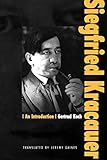Siegfried Kracauer : An Introduction / Gertrud Koch.
Material type: TextPublisher: Princeton, NJ : Princeton University Press, [2000]Copyright date: ©2000Edition: Core TextbookDescription: 1 online resource (200 p.) : 1 line illusContent type:
TextPublisher: Princeton, NJ : Princeton University Press, [2000]Copyright date: ©2000Edition: Core TextbookDescription: 1 online resource (200 p.) : 1 line illusContent type: - 9780691049922
- 9781400823642
- 834/ .912 21
- PT2621.R135 Z7613 2000eb
- online - DeGruyter
- Issued also in print.
| Item type | Current library | Call number | URL | Status | Notes | Barcode | |
|---|---|---|---|---|---|---|---|
 eBook
eBook
|
Biblioteca "Angelicum" Pont. Univ. S.Tommaso d'Aquino Nuvola online | online - DeGruyter (Browse shelf(Opens below)) | Online access | Not for loan (Accesso limitato) | Accesso per gli utenti autorizzati / Access for authorized users | (dgr)9781400823642 |
Browsing Biblioteca "Angelicum" Pont. Univ. S.Tommaso d'Aquino shelves, Shelving location: Nuvola online Close shelf browser (Hides shelf browser)

|

|

|

|

|

|

|
||
| online - DeGruyter Rude Republic : Americans and Their Politics in the Nineteenth Century / | online - DeGruyter Society and Sentiment : Genres of Historical Writing in Britain, 1740-1820 / | online - DeGruyter Literary Criticisms of Law / | online - DeGruyter Siegfried Kracauer : An Introduction / | online - DeGruyter The Masochistic Pleasures of Sentimental Literature / | online - DeGruyter Outsiders Together : Virginia and Leonard Woolf / | online - DeGruyter Reform in the Making : The Implementation of Social Policy in Prison / |
Frontmatter -- Contents -- Preface -- Time Line of Kracauer's Life -- CHAPTER 1. The Early Days: A Biographical Sketch -- CHAPTER 2. The Early Phenomenology of Modernity and Mass Culture: Of Hotel Lobbies and Detective Novels -- CHAPTER 3. Surface and Self-Representation: "The Mass Ornament" and Die Angestellten -- CHAPTER 4. Autobiography and Social Biography: Ginster, Georg, and Offenbach -- CHAPTER 5. Continuity and Mentality: "From Caligari to Hitler" -- CHAPTER 6. Space, Time, and Apparatus: The Optical Medium "Theory of Film" -- CHAPTER 7. At the End: A Philosophy of History and Historiography -- Notes -- Bibliography -- Index
restricted access online access with authorization star
http://purl.org/coar/access_right/c_16ec
Siegfried Kracauer has been misunderstood as a naïve realist, appreciated as an astute critic of early German film, and noticed as the interesting exile who exchanged letters with Erwin Panofsky. But he is most widely thought of as the odd uncle of famed Frankfurt School critical theorists Jürgen Habermas, Theodor Adorno, Walter Benjamin, and Max Horkheimer. Recently, however, scholars have rediscovered in Kracauer's writings a philosopher, sociologist, and film theorist important beyond his associations--and perhaps one of the most significant cultural critics of the twentieth century. Gertrud Koch advances this Kracauer renaissance with the first-ever critical assessment of his entire body of work. Koch's analysis, which is concise without sacrificing thoroughness or sophistication, covers both Kracauer's best-known publications (e.g., From Caligari to Hitler, in which he gleans the roots of National Socialism in the films of the Weimar Republic) and previously underexamined texts, including two newly discovered autobiographical novels. Because Kracauer's wide-ranging works emerge from no rigidly unified approach, instead always remaining open to unusual and highly individual perspectives, Koch resists the temptation to force generalization. She does, however, identify recurring tropes in Kracauer's lifetime effort to perceive the basic posture and composition of particular cultures through their visual surfaces. Koch also finds in Kracauer a surprisingly contemporary cultural commentator, whose ideas speak directly to current discussions on film, urban modernity, feminism, cultural representation, violence, and other themes. This book was long-awaited in Germany, as well as widely and well reviewed. Now translated into English for the first time, it will fuel already growing interest in the United States, where Kracauer lived and wrote from 1941 until his death in 1966. It will attract the attention of students and scholars working in Film Studies, German Studies, Comparative Literature, Critical Theory, Cultural Studies, Philosophy, and History.
Issued also in print.
Mode of access: Internet via World Wide Web.
In English.
Description based on online resource; title from PDF title page (publisher's Web site, viewed 29. Jul 2021)


